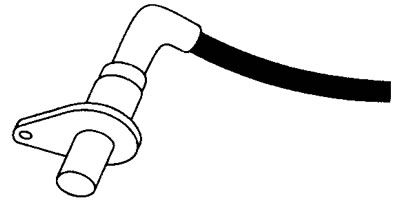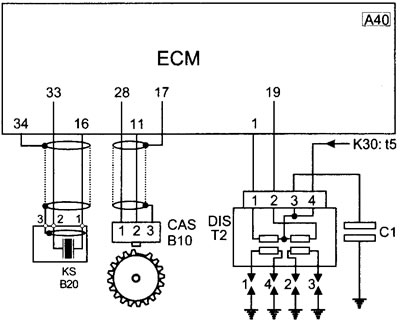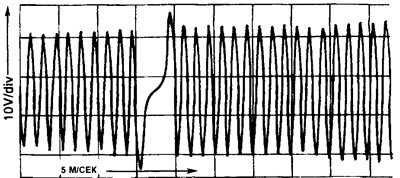Setting the ignition timing
The ignition timing setting on models equipped with the MM 8P system is not adjusted in the usual way. However, it is possible to adjust the curved ignition timing with the appropriate DTC reader (FCR). This task should not be taken lightly, but the condition of the engine and system functions should be checked and evaluated before starting to adjust the ignition timing.
| Cylinder numbers | The order of operation of the cylinders | Displayed advance |
| 4 | 1-3-4-2 | 10-8° |
Amplifier
The MM 8P system amplifier contains a circuit for switching the negative terminal of the ignition coil at the right time to turn on the ignition system. The amplifier circuit is included in the electronic control unit. The microprocessor controls the duration of the closed state of the ignition interrupter contacts at all operating loads on the engine and at the voltage supplied from the battery. The amplifier located inside the electronic control unit has one drawback - if the amplifier fails, then it is necessary to replace the entire electronic control unit.
Crank angle sensor (CAS)
crank angle sensor (CAS), which determines the fuel injection time and ignition timing, is located next to the flywheel (see illustration 12.5). The crank angle sensor consists of an inductive magnet that emits a magnetic field. The flywheel includes a disc containing a set of steel pins set at intervals. When the flywheel rotates, the pins also rotate in the magnetic field, an AC voltage signal is supplied to the electronic control unit to determine the rotation speed. Two missing pins (separation by 180°С) are the TDC reference mark and indicate the position of the crankshaft by changing the signal as the flywheel rotates. One missing pin indicates the TDC position for pistons of cylinders No. 1 and No. 4, and the other pin indicates the TDC position for pistons of cylinders No. 2 and No. 3.

12.5 Crank angle sensor (CAS)
Peak-to-peak voltage signal (looking at an oscilloscope) can vary from 5 V at idle to more than 100 V at 6000 rpm. The electronic control unit uses a digital converter to change the AC pulse into a digital signal.
Voltage values of the crank angle sensor (CAS)
Terminal numbers

See illustration 12.6

12.6 Electrical connection diagram of the primary winding of the ignition coil of the crank angle sensor / knock sensor
Crank Angle Sensor Resistance Values (CAS)
Terminal numbers
| CAS | ECM | Resistance (W) |
| 1 and 2 | 28 and 11 | 300 - 500 |
| 1 and ground | 28 and 17 | Infinity |
| 2 and ground | 11 and 17 | Infinity |
Adjustment
Air gap
Influence of external factors
- Incorrect air gap
- Faulty or incorrectly installed flywheel
Checking the crankshaft angle sensor (CAS) (general check)
1. Inspect the crank angle sensor multi-pin connector for signs of corrosion or damage.
2. Make sure the connector pins are properly installed and making good contact with the crank angle sensor multi-pin connector.
3. Remove the crank angle sensor from the engine block. Inspect the end face for signs of corrosion and damage.
4. Measure the resistance of the crank angle sensor and compare it with the specifications. See resistance determination checks at the end of this chapter.
5. The presence of the faults listed above is a common cause indicating a defective sensor or a signal failure from the crankshaft angle sensor.
Checking the CAS Output with an Oscilloscope (when turning the crankshaft)
Note. This test should be carried out with the engine not running.
1. Disconnect the crank angle sensor multi-pin connector (CAS) or electronic control unit (ECM).
2. Connect an oscilloscope between terminals 1 and 2 of the crank angle sensor or the corresponding terminals of the ECM multi-pin connector.
3. Turn the crankshaft, the device should indicate a minimum voltage of approximately 4.0-5.0 V (full swing).
4. Check for peak uniformity. If one or more values are much less than the others, then this indicates damage to the crank angle sensor cam.
5. If there is no signal, or if the signal is very weak or unstable:
- Measure the resistance of the crank angle sensor (CAS).
- Check the sensor for damage and contamination with dirt or oil.
- Check flywheel for damage.
- Check the air gap of the crank angle sensor (CAS) (if possible).
Oscilloscope Checking the Output Signal of the Crank Angle Sensor
On a running engine
1. Connect the multi-pin connector of the crank angle sensor (CAS) or electronic control unit (ECM) And (where possible) bend the insulation to obtain voltage by connecting the voltmeter probes to the crank angle sensor terminals (or connect output unit (WWII) between the multi-pin connector of the electronic control unit and the electronic control unit).
2. Best results are usually obtained by connecting probes to the terminal (+), although quite often the waveform can be obtained by connecting probes to the ground terminal of the crank angle sensor.
3. Run the engine at various speeds and check the stability of the signal (see illustration 12.7).

12.7 Typical crank angle sensor output waveform (CAS)
Checking the Crank Angle Sensor Output with an AC Voltmeter (CAS)
When turning the crankshaft
Note. This test should be carried out with the engine not running.
1. Disconnect the crank angle sensor multi-pin connector (CAS) or electronic control unit (ECM) and connect an AC voltmeter between the crank angle sensor terminals.
2. Turn the crankshaft. The device should show approximately a minimum of 0.7 V (rpm), although most good sensors provide an output voltage of more than 1.4 V (rpm).
Note. The AC voltmeter at least proves that the crank angle sensor is producing a signal. However, the AC voltage is a medium voltage and therefore does not accurately indicate damage to the crank angle sensor cams.
Checking the Crank Angle Sensor Output with an AC Voltmeter (CAS)
On a running engine
Note. Measuring the output voltage with the engine running will be a little tricky.
1. Connect the multi-pin connector and bend the insulation (where possible), to obtain voltage by connecting the voltmeter probes to the sensor terminals.
2. Start the engine and let it idle. AC voltage (VAC) (rpm) can be displayed at different engine speeds by adjusting the throttle.
Note. It's possible (even probably), that the engine will not start with a voltmeter connected. Alternatively, if a voltmeter is attached while the engine is running, it may stall or even misfire when the throttle is opened.
3. Start the engine at 2000 rpm first, and then connect the voltmeter leads, the large output voltage at this rpm is usually enough to keep the engine running. The motor will not be damaged if the specifications are followed when connecting the voltmeter.
Checking the resistance of the crankshaft angle sensor (CAS) using an ohmmeter
1. Disconnect the crank angle sensor multi-pin connector (CAS) or electronic control unit (ECM) and connect an ohmmeter between the two terminals leading to the sensor.
2. Record the resistance obtained and compare it with the resistance values of the crank angle sensor (CAS).
Note. Even if the resistance is within specification, it does not prove that the crank angle sensor can produce an acceptable signal.
Shielded sensor wire (CAS)
1. Crank angle sensor (CAS) may have shielded wire (not in all cases). Locate the multi-pin connector of the electrical wiring or disconnect the multi-pin connector of the electronic control unit (ECM).
2. Attach an ohmmeter probe to one of the No. 1 or No. 2 terminals of the sensor.
3. Attach another ohmmeter probe to the shielded wire terminal. The device should show infinite resistance.
4. Disconnect the ohmmeter probe from the shielded wire terminal and connect it to ground. You should also get an indication of infinity.
Note. In some systems, the shielded wire of the crank angle sensor is connected to the ground wire of the crank angle sensor. In this case, the presence of conductivity will be registered by an ohmmeter, and this is normal for this car. See the wiring diagrams to determine which wires connect the crank angle sensor.
